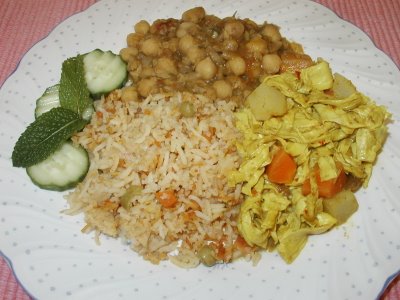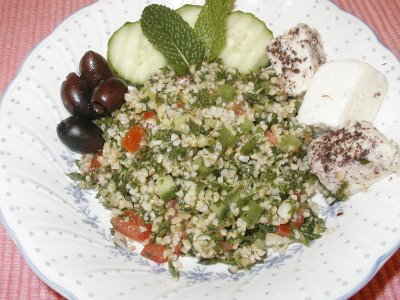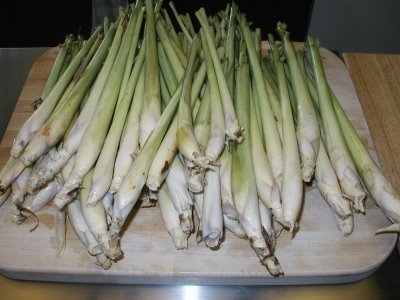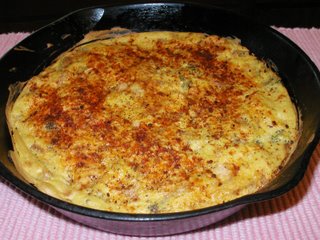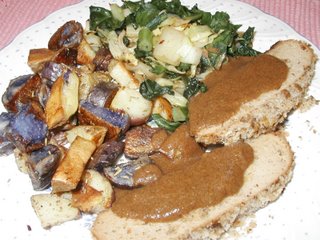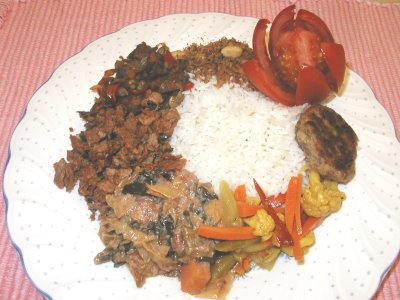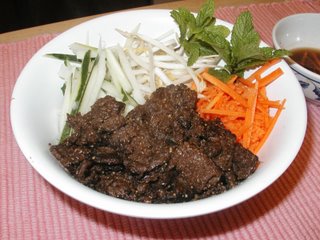 |
| Vietnamese BBQ Noodle Salad |
These Vietnamese salads are excellent for hot weather meals. No, summer is not here yet, we have a bright and sunny spring weather for a change, but I wanted to make them since they are low in fat but delicious. To help me loosing weight, I eat Vietnamese vegan dishes such as Vietnamese Salad Rolls (spring rolls), Vietnamese Pho, and these salads: Vietnamese BBQ Noodle Salad and Young Jackfruit salad(the 2nd picture below). They are yummy and refreshing!
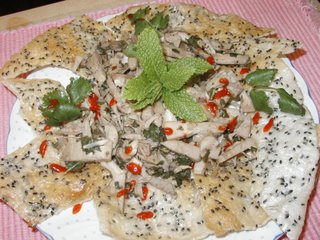
To enhance the BBQ noodle salad to be more nutritious, I use Japanese
Zaru Soba which I found in the Korean market near our house to replace the white rice noodle. The Zaru Soba is thin like vermicelli but it is made of wheat flour, buckwheat flour, yam, salt, and water. In fact, I thought it will be good for Pho or any pasta dish that uses white pasta. Zaru means a draining basket made of bamboo which can be used as cooking and presentation according to wikipedia.org (
click here for more information).

For the Vietnamese BBQ noodle salad, I served the cooked and well drained soba in a bowl topped with fresh vegetables such as thin strips of carrots, thin strips of cucumber, fresh bean sprouts, and fresh mint leaves from our garden. Then, I topped it with grilled marinated Vietnamese BBQ slices made from ‘beefy’ TVP which were grilled on our Cuisinart indoor grill. At the end of the BBQing process, I sprinkled the BBQ slices with roasted rice powder which makes them so tasty.
Roasted rice powder is commonly used in Vietnamese dishes and very easy to make. I pan fried dry (without oi) uncooked rice on a frying pan until they are golden brown. Let it cool and then grind into a powder in a mini blender. This dish is served with sweet and sour dressing on the side. The last topping is chopped roasted peanuts. Pour the salad dressing over the noodle dish just before eating, mix them all up, and enjoy. It is usually served at room temperature which is perfect as a picnic or lunch in the office or travelling dish.
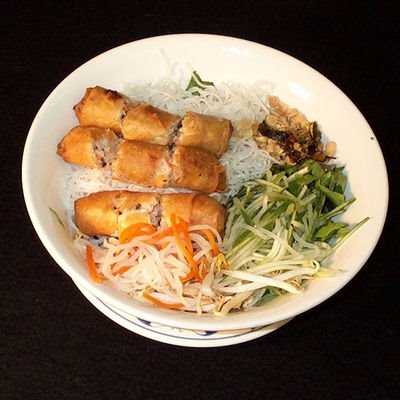
Vietnamese noodle salad is usually served with deep fried Vietnamese eggrolls. It is very yummy but also has more oil and fat content so, at home, I opt to serve without them. In vegetarian Vietnamese restaurants, you can order a combination of eggrolls and BBQ TVP slices on top, a common way to serve it. The salad dressing in restaurants is generally too sweet for my husband’s taste so he usually don’t use much of the dressing. My recipe uses less sugar (I actually use Agave Nectar). It is a matter of taste, you can add more sugar if you want.

Young Jackfruit salad is unusual for us here in the US. I actually didn’t know about this salad until I became a vegan and explored the vegetarian restaurants near us. Of course, I cannot get fresh young jackfruit here since it is a Southeast Asian fruit but I can buy them in cans soaked in brine at the Asian market. It is the YOUNG jackfruit that I used here and not the RIPE yellow jackfruit which is totally different in smell and taste.
This salad is served room temperature and is sour and refreshing, similar to Thai Som Tum (young papaya salad). It is topped with roasted chopped peanuts, chopped cilantro, and drizzle of fresh squeezed lime juice and Sriracha hot sauce. It is served with Vietnamese sesame rice crackers on the side which are used to scoop the salad with (sort of like eating Mexican Nachos).
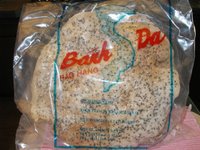
The Vietnamese Sesame Rice Crackers or Chips are also unique and available only in Vietnamese markets. It is called
Banh Da and is made of tapioca flour, rice flour, salt, and sprinkled with black sesame seeds. It is toasted or roasted which causes it to puff up and become crispy like chips. This time I bought them ready made from the market.

Other times I buy the raw ones in a plastic container which looks like rice papers used for Vietnamese spring rolls. I usually roast these on an open fire or a hot grill. Although this cracker does not look that appetizing on the picture, it is yummy with the salad. If Banh Da is not available, you can substitute it with Indian papadum, Mexican tortilla chips, or Japanese rice crackers.
Vegan Vietnamese BBQ Noodle Salad
I often order this dish in a vegetarian Vietnamese restaurant near my house. The dish is low fat but full of flavor (from the lemon grass and five spice powder). I usually pour all the sweet and sour dressings over the noodles and mix them all together. This is a cold noodle dish and can be eaten at a room temperature which is perfect as a picnic or travelling dish. What makes the BBQ TVP slices taste savory is the dry roasted rice powder which is a common use in Vietnamese cuisine.
Servings: 6
Printable Recipe
Ingredients:
2 1/2 cups dry vegetarian protein meat slices (TVP) or Soy Curls
16 oz Rice noodles (same one use in Vietnamese Pho noodle) or zaru soba
2 carrots, cut into thin strips
1 cup mint leaves, shred into individual leaves
1 cucumber, cut into thin strips
1 cup bean sprouts or shredded lettuce leaves
3 Tbsp roasted rice powder (see tip)
2 tsp canola oil
3 Tbsp roasted peanuts, chopped
Seasonings for marinade:
1/3 cup soy sauce or 2 1/2 Tbsp dark mushroom soy sauce mixed with 2 1/2 Tbsp water
3 tsp sugar or 1 1/2 Tbsp Agave Nectar
1 tsp onion or or 'chicken' or mushroom broth powder
1/2 tsp ground black pepper
1/4 tsp good quality 5 spice powder
1 tsp sesame oil
1 stalk fresh lemongrass, chopped
Sweet and Sour Salad dressing:
1/3 cup water
1/3 cup fresh lemon/lime juice
3 to 4 Tbsp vegetarian fish sauce or Bragg's Liquid Amino
3 Tbsp Agave Nectar or 3 tsp sugar, or to taste
Notes: my husband don't like the sauce too sweet like in the restaurants so I made this sauce more in the sour taste.
1 tsp chili garlic sauce, sambal oelek or Korean red pepper powder, or less for less spicy
- If using dry TVP slices, simmer the dried veg protein in warm water for 20 to 30 minutes. Then, squeeze all the water out. Or, an alternative method which I like is to pressure cook the dry TVP slices in 3 or 4 cups water on high for 2 minutes. Then, use the quick release method. The TVP slices will be very soft. Let it cool and then squeeze the water out.
- If using soy curls, reconstitute them with 2 1/4 cups of hot water for 10 minutes. Then, squeeze the water out.
- Combine seasonings for marinade in a blender including the chopped fresh lemon grass stalk. Blend the sauce until well blended and the lemon grass is pulverized into very small bits.
- Mix the seasoning sauce with the veg protein (reconstituted tvp or soy cutlets) to marinade for at least 1 hour.
- Meanwhile, cook the rice noodles in a hot boiling water for 1 minute (or soba for 4 minutes). Take it off heat and soak for a few more minutes. Test if the noodle is soft. When the noodles are soft, drain it over a colander and rinse it with cold tap water so it will stop the cooking process.
- Heat your indoor bbq grill or a heavy skillet like a cast iron, high heat.
- Saute the marinated protein slices. Drizzle canola oil to prevent sticking. Cook until they are brown and looked like they have been barbequed. I use an indoor BBQ grill with less oil.
- Remove from heat. Add 3 Tbsp of roasted rice powder and mix well. Serve in a bowl on top of the drained rice noodle or soba and vegetables with Sweet and Sour dressing on the side. Sprinkle the roasted chopped peanuts on top
Nutrition Facts
Nutrition (per serving): 460.1 calories; 11% calories from fat; 5.9g total fat; 0.0mg cholesterol; 1499.5mg sodium; 475.2mg potassium; 84.3g carbohydrates; 2.3g fiber; 13.9g sugar; 82.0g net carbs; 25.4g protein; 9.2 points.
Cooking Tips for Roasted Rice Powder: Dry fry rice on cast iron pan in medium heat until rice became opaque and light brown, about 5 minutes. Let it cool. Grind in a mini blender or a spice grinder until it becomes a powder.
Vegan Vietnamese Young Jackfruit Salad
This young jackfruit salad is served at a vegetarian Vietnamese restaurant near my house. It is sour, a bit sweet, and spicy like Thai Somtum (young papaya salad). It is served on top of Vietnamese sesame chips that are available in Vietnamese markets but it can be substituted with Indian pappadums. Originally, it is made with fish sauce but I am able to substitute is with vegetarian fish sauce. Bragg's Liquid Amino tastes similar to vegetarian fish sauce and can be used for this dish. With drizzles of Sriracha hot sauce, roasted peanuts, squeezed lime wedges, and chopped cilantro, this dish is crunchy, delicious, and refreshing.
Ingredients:
2 cans young jackfruit in brine (each can is 8 oz drained weight, total = 1lb.), drained,rinse in water, squeeze out the water and cut into strips (vertically according to its grain)
2 tsp. canola oil
4 cloves garlic, minced
3/4 cup shallots or green onions, chopped
1 cup Thai/Vietnamese basil, loosely packed, chopped
1 tsp. sea salt
1/2 tsp. black pepper
1 Tbsp. vegan sugar
2 1/2 Tbsp. Vegetarian Fish Sauce or Bragg's Liquid Amino
1 to 2 Tbsp. fresh lemon juice
1 tsp dulse granules
Serve with:
1/4 cup roasted peanuts, chopped
1/4 cup cilantro, chopped
1/4 cup Thai/Vietnamese basil, chopped, optional
Fresh lime wedges, Sriracha hot sauce, Vietnamese sesame chips or Indian Pappadum
- Preheat wok. When the wok is hot, add oil, garlic, and onion. Stir fry until fragrant. Add young jackfruit strips, salt, sugar, black pepper, and vegetarian fish sauce or liquid amino. Mix and stir-fry in high heat for 10 minutes until spices are absorbed to the jackfruit. Add water to the wok to prevent sticking.
- Add 1tsp. dulse granules, mix well. Stir fry for 2 minutes.
- Add lemon juice and Thai/Vietnamese basil. Mix well for 1 minute.
- Turn off heat. Set aside jackfruit in a bowl and let it cool.
- Serve the salad room temperature on a plate with chopped roasted peanut and chopped cilantro/basil sprinkled on top.
- Dot it with Sriracha hot sauce on top and all over the salad. Each person can use the sesame crackers/pappadum to scoop the salad, dot with fresh squeezed lime juice and more vegetarian fish sauce.
Nutrition Facts (without sesame crackers): (per serving): 157.3 calories; 26% calories from fat; 4.9g total fat; 0.0mg cholesterol; 484.9mg sodium; 424.8mg potassium; 28.3g carbohydrates; 2.6g fiber; 2.8g sugar; 25.7g net carbs; 4.0g protein; 3.0 points.
